The Apple Watch Review
by Joshua Ho & Brandon Chester on July 20, 2015 8:00 AM EST- Posted in
- Wearables
- Apple
- Mobile
- Apple Watch
Apple Pay
I normally don’t cover mobile payment solutions, but in the case of the Apple Watch I suspect this is the fastest way for anyone not using an iPhone 6/6 Plus to get Apple Pay access. Although I’ve never written anything about Apple Pay on the iPhone 6, in my experiences it’s probably the best solution around when it comes to easy payment due to the NFC boosting that makes the iPhone 6 send and receive NFC with no real orientation dependence and TouchID payment authentication. Coming into this review, the real question for me is whether Apple Watch could have the same seamless experience.
To try and figure out the answer to that question, there are really a few elements to the payment experience that have to be figured out. The first is authentication, which can easily be the biggest downfall in the experience. To this end, Apple has figured out a pretty smart system of wrist detection combined with a PIN code which ends up making for a pretty seamless experience. At the start of the day, you input your passcode when you put on the watch, and any time the watch is removed you have to input the passcode again or else pretty much everything (including Apple Pay) is locked out. If you lose your watch, no one can access the payment component without your PIN.
This effectively means that when you’re paying for something with the watch, all you have to do is double-tap the side button to activate Apple Pay. I’m not sure why it’s strictly necessary for NFC to be off unless the user activates it, but it’s likely that even the standby power of NFC would be significant with the battery of the Apple Watch.
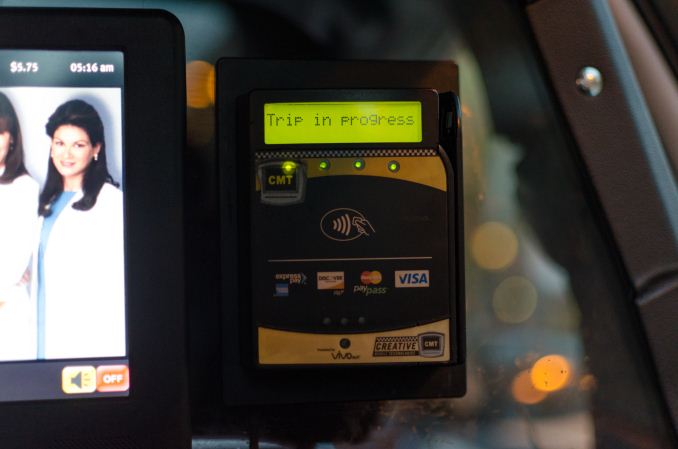
This payment terminal was at head-level in the back of a taxi
The second potential roadblock is ease of use with payment terminals. To this end, the RF component is actually without issue. I didn’t find myself particularly constrained in terms of distance or orientation of the watch to interface with readers. However, I think the problem with payments on the Apple Watch is that in some cases readers are just placed in positions that require some really odd contortions to get the watch to the reader, regardless of whether the NFC RF subsystem is well-designed. Anything at chest or waist level was usually without problems, but I noticed that readers mounted at head-level were remarkably difficult to use with Apple Watch. Other issues like setup for card payments were really without issue, and I suspect most people won’t have any problems setting up their watch for Apple Pay.
Ultimately, while Apple Watch will work just as well as an iPhone 6 for payments, the real downfall here is mostly a problem of physiology. While in some cases using the watch for payments is a natural gesture, there are a number of edge cases that require a lot of contortion to get the watch to the payment terminal. If you don’t have an iPhone 6/6 Plus and you want to use Apple Pay, Apple Watch is probably the best way of getting Apple Pay. However, I still think the smartphone is a better platform for payments for ergonomic reasons.
WatchOS Final Words
The Apple Watch has a completely new OS, which warrants some especially close scrutiny of the OS as any early design decisions made have a tendency to snowball in terms of momentum, so it’s almost impossible to make some changes once applications are widely using shared libraries and APIs that are expected to work in a temporally consistent manner. To recap for those that don’t want to read everything previously discussed, there are a few areas that are worth examining in WatchOS, namely the watch functionality itself, notification handling, glances, apps, communication, fitness, and Apple Pay.
The watch functionality is solid, and Apple has created a number of compelling, useful, and deeply customizable watchfaces. The use of Force Touch and digital crown here makes a lot of sense when it comes to training the user for the rest of the UI, and the ease of use in customizing the watchface is truly great. There is the issue of no public API for watchfaces, but I suspect that this will come with time as it’s important to ensure that such an API is properly designed for long term support. Glances are well-executed and a useful feature, but I don’t really get the point of integrating heart rate monitoring into a glance or similar cases of app information as anything important to me ends up as a complication on the watchface. In practice, I think glances are best thought of as quick settings toggles rather than sources of glanceable information. To this end, the ability to turn on power reserve mode, toggle airplane mode, silent mode, do not disturb mode, and ringing the paired iPhone, and other controls like music playback control are definitely welcome and make a lot of sense.
When it comes to notification handling, once again I think Apple has done an effective job from a UI perspective as the notification shade uses familiar constructs from iOS/Android and the use of Force Touch to dismiss all notifications is a nice touch. However, I do have issues with how multiple simultaneous notifications are handled, which should be converted into a list view of all notifications rather than a single notification that indicates there are multiple notifications from the same application. Other than this, I think Apple has done a solid job with all the necessary features (do not disturb, actionable notifications, dismiss all, smooth UI). From a broader UX perspective the Taptic Engine is good enough to be worthy of a separate discussion, but within the context of notifications it works well.
Apps are ultimately what make a platform, because at the end of the day the reason why people use any general purpose computer is because of the apps that it can run. To this end, there’s currently a huge division in quality and functionality between first-party and third-party apps. Apple’s applications are executed well, with pretty much all the functionality that makes sense and great design. I never really had any frustrating moments with Apple’s apps on the watch. For any kind of input, there was always the ability to use Apple keyboard predictions or Siri voice input, which covered just about every case in which I wanted to input some kind of text in reply.
However, the same can’t be said of third-party apps. Probably the best example of this is Uber, which is literally just a button to request a pick-up with no other options when I can easily imagine a UI leveraging the digital crown to precisely indicate pickup, and swipes or Force Touch to select the type of Uber I want to use. This kind of UI is simple, but arguably too simple for a watch with as many UI tools as Apple Watch. I’m not sure that “native apps” will necessarily fix everything here, but native apps combined with developer experience and more powerful hardware will probably deal with most of the complaints I have about third party apps for WatchOS 2.
Communication is really a part of apps, but deserves specific mention because it’s such a critical task of the Apple Watch. To that end, there are really three key native apps that fall under this category. These are the phone, messages, and email application. All of these are well-executed, and in practice the user experience around all of these is pretty much painless. One could argue that email is missing some functionality, but for at a glance email viewing it works pretty much as it should. Fitness falls under a similar category in the sense that it’s a subset of the apps category, but if nothing else, Apple has made a great fitness tracking application when it comes to information presented, design, and ease of use. Apple Pay is also well-implemented in terms of ease of use, but there’s a fundamental issue with ergonomics that prevents Apple Pay on the watch from being as great as it is on the iPhone.
Overall, I think Apple has created an OS that is forward-looking and fully capable of supporting future iterations of Apple Watch without too much trouble, although many details will change as time goes on. However, for early adopters I suspect there will be some objection to performance. As one might be able to guess from our S1 CPU analysis, the S1 SiP is not going to be able to come close to a modern smartphone for performance, which means that even basic UI tasks can be a bit of a struggle with visibly-dropped frames when scrolling and swiping through some parts of the UI like the fitness app. There’s also the issue of app load times, but I suspect this will disappear with the inevitable advance of Moore’s law and native apps can load almost instantly in some cases.
Currently, third-party apps are lacking either from the lack of native app support or from general unfamiliarity of design principles for the watch. Probably the only real criticism I have for the OS overall is that there’s currently a distinct lack of watch independence, as if I set the iPhone to airplane mode but keep the watch able to connect to the internet applications like weather are unable to download anything even though it should be able to connect to my home router and download this kind of information anyways. Given the number of constraints that come with the wearable form factor, WatchOS is probably one of the best OSes out there for wearables.


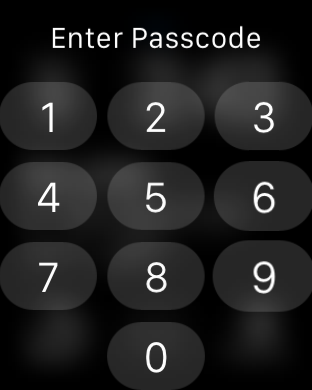
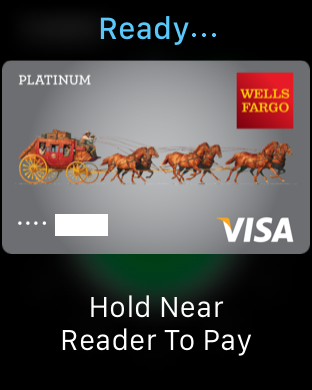
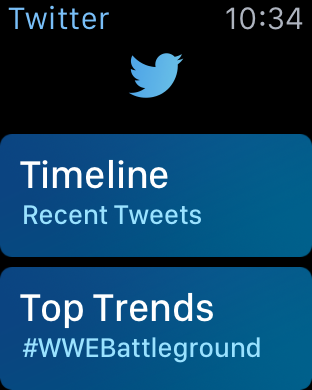
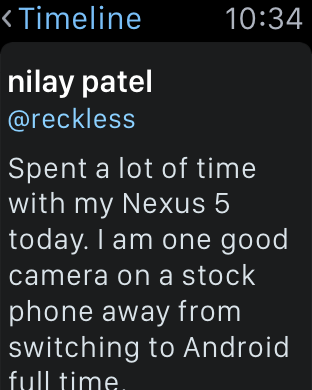

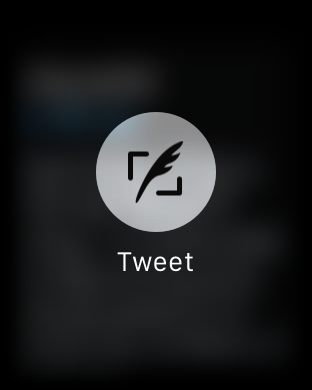
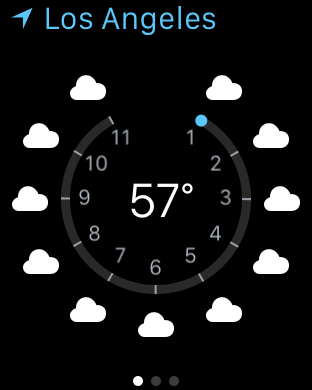
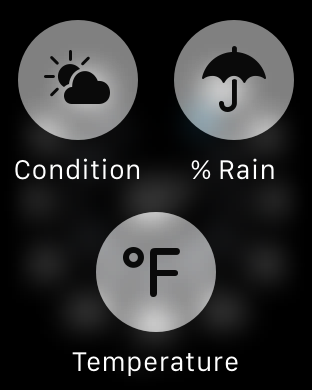


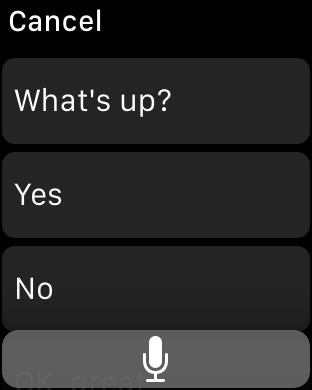
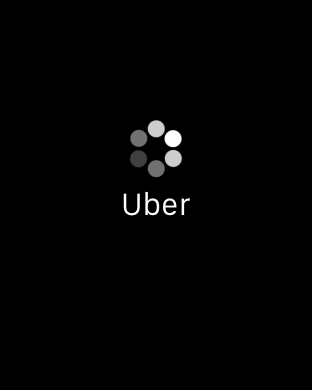


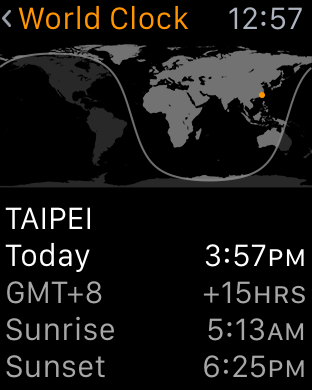

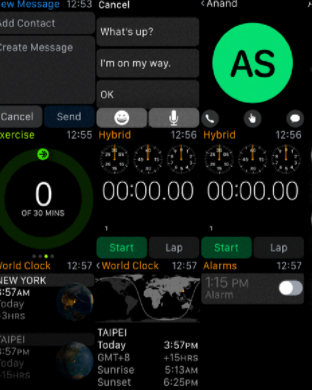
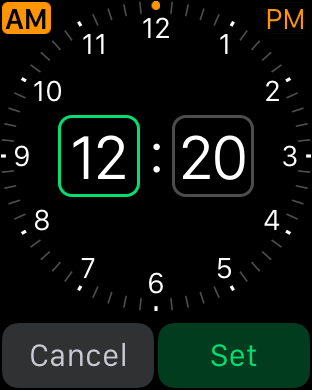
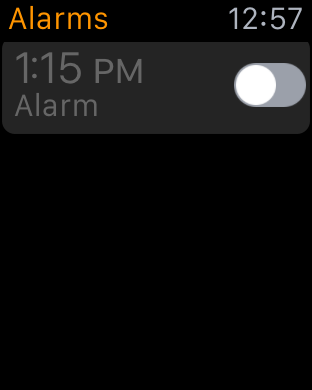








270 Comments
View All Comments
supermoon7 - Monday, October 12, 2015 - link
You're so right! Use the watch for what it's intended for. It's not a computer. According to the guys at http://www.watchtimely.com it was originally meant to have a slightly larger screen to be able to do more complicated things, but the developers realized nobody would do them on their watch anyway.xihan94 - Friday, September 11, 2015 - link
+1 for the uncovered bonus chromosome 21.johnnycanadian - Monday, July 20, 2015 - link
... you seem to have a tremendous amount of time on your hands. Perhaps learning a new skill would be valuable?Schickenipple - Tuesday, July 21, 2015 - link
This guy has written book-length posts on pretty much every Apple product review. It's quite sad, really.I'd have to imagine that ANY skill other than ranting on and on about something he's never even used would go a long way... A career, maybe?
iWatchHogwash - Monday, July 20, 2015 - link
Dera BittenRottenApple,Excellent Analysis, what a great read, rationally and logically consistent, thank you very much.
By the way, some further recommendations to read and watch:
https://www.facebook.com/pages/I-hate-Apple/511277...
http://www.businessinsider.com/10-things-we-really...
https://www.youtube.com/watch?v=qa9d5mXc7eg&fe...
https://www.youtube.com/watch?v=90NJOpjq02M
http://www.fudzilla.com/news/wearables/38007-new-y...
http://www.nytimes.com/2015/04/09/technology/perso...
http://www.fudzilla.com/news/wearables/37610-lg-re...
Other Apple news not mentioned here:
Apple Watch sales fall by 90 per cent
Apple has another lemon
It is turning out exactly as we said – sales of Apple's latest cure for cancer have slumped to a shadow of their initial "glory."
While the Tame Apple Press and a big chunk of analysts sung praises for the iWatch, claiming it would sell 70 million in its first year. We pointed out that the gizmo was nearly two years out of date and lacked most of the software which would make it moderately useful and if it succeed it was a triumph of user stupidity and marketing.
Lately analysts have been slowly withdrawing the enthusiastic sales figures they gave the watch, and now a new survey has shown that sales have fallen by 90 per cent.
Apple is selling fewer than 20,000 watches a day in the US since the initial surge in April, and on some days fewer than 10,000. This is not too bad, but it does suggest that most people who wanted an iWatch have one, and existing users are not managing to win many converts amongst their friends to make it take off. For the record to make the 70 million figure apple would have to sell 195,000 a day.
Data collected by Slice Intelligence show that Two-thirds of the watches sold so far have been the lower-profit "Sport" version, whose price starts at $349, according to Slice, rather than the costlier and more advanced models that start at $549. Apple's gold "Edition" model priced at $10,000 or more has only sold 2,000 of them have been sold in the US.
The figures are based on the electronic receipts sent to millions of email addresses following purchases. The company conducts market research on behalf of consumer-goods companies, among others, many of them in the Fortune 500.
All up though these figures are not bad, but they are not the sort of numbers which Apple needs to convince its investors that it can make mega sales any more. With sales drying up in China, Jobs mob will not have a good bottom line this year.
Source:
http://www.fudzilla.com/news/wearables/38173-apple...
And
Apple puts iWatch in stores
Maybe some idiot will buy them
Apple mysteriously has enough iWatches on hand to start putting them in its own stores.
The iWatch went on sale six weeks ago and at the time Apple did not think it would ever have enough to put it in its own shops. The original plan was to flog them online and in fashion stores, however and Jobs' Mob thought it would never have enough to meet the crushing demand for an out-of-date wearable which was more expensive than anything else on the market.
So it appears that suddenly Apple has enough. Of course the Tame Apple Press is trying to keep the story about a shortage going. Potential buyers must first reserve their device online, and some models are still out of stock.
But the sport models, which are most popular and the cheapest, are available across the country, while others can be bought in Apple's flagship shops, such as those in London and Manchester.
In order to reserve your device, you must pick the Watch you want to buy, choose a store to pick the device up and then choose a time to go and buy it.
You can also order the home delivery, but it's not recommended as it takes more than three weeks for the shipment to be delivered.
The most expensive models, such as the 38mm yellow gold model with red modern Buckle strap, are still unavailable. As Apple said last week, the 42mm Watch in Space Black with the metal link bracelet is unavailable at all stores for now.
Source:
http://www.fudzilla.com/news/wearables/38018-apple...
Finally some related news (pasted in chronological order from new to old):
http://www.fudzilla.com/news/38274-apple-press-gea...
http://www.fudzilla.com/news/wearables/38254-apple...
http://www.fudzilla.com/news/wearables/38173-apple...
http://www.fudzilla.com/news/wearables/38126-analy...
http://www.fudzilla.com/news/wearables/38018-apple...
http://www.fudzilla.com/news/38017-apple-is-convic...
http://www.fudzilla.com/news/wearables/38007-new-y...
http://www.nytimes.com/2015/04/09/technology/perso...
http://www.fudzilla.com/news/38004-xiaomi-sells-6-...
http://www.fudzilla.com/news/37983-twitter-thinks-...
http://www.fudzilla.com/news/wearables/37893-zenwa...
http://www.fudzilla.com/news/wearables/37889-apple...
http://www.fudzilla.com/news/37832-analyst-realise...
http://www.fudzilla.com/news/37787-quanta-clarifie...
http://www.fudzilla.com/news/wearables/37756-apple...
http://www.fudzilla.com/news/wearables/37660-iwatc...
http://www.fudzilla.com/news/wearables/37646-apple...
http://www.fudzilla.com/news/37635-apple-results-s...
http://www.fudzilla.com/news/wearables/37610-lg-re...
http://www.fudzilla.com/news/37609-is-the-iphone-a...
http://www.fudzilla.com/news/wearables/37586-apple...
http://www.fudzilla.com/news/wearables/37558-apple...
http://www.fudzilla.com/news/37499-imac-is-getting...
http://www.fudzilla.com/news/wearables/37485-apple...
http://www.fudzilla.com/news/wearables/37391-apple...
http://www.fudzilla.com/news/wearables/37350-apple...
http://www.fudzilla.com/news/37349-apple-a-trillia...
http://www.fudzilla.com/news/mobile/37278-new-ios-...
http://www.fudzilla.com/news/37248-apple-blames-se...
http://www.fudzilla.com/news/wearables/37235-devel...
http://www.fudzilla.com/news/mobile/37224-iphone-i...
http://www.fudzilla.com/news/wearables/37130-mobil...
http://www.fudzilla.com/news/wearables/37048-apple...
http://www.fudzilla.com/news/wearables/37001-study...
http://www.fudzilla.com/news/wearables/36699-apple...
http://www.fudzilla.com/news/wearables/36603-consu...
http://www.fudzilla.com/news/wearables/36427-sony-...
http://www.fudzilla.com/news/36342-intel-outclasse...
http://www.fudzilla.com/news/mobile/36183-microsof...
http://www.fudzilla.com/news/mobile/36169-microsof...
http://www.fudzilla.com/news/36080-microsoft-beats...
http://www.fudzilla.com/news/mobile/35959-apple-wa...
http://www.fudzilla.com/news/35740-doctors-rubbish...
http://www.fudzilla.com/news/mobile/35694-rumour-i...
Have a nice day.
Ryan Smith - Monday, July 20, 2015 - link
In the interest of transparency, BittenRottenApple has been banned from AnandTech. We have since identified him as a sockpuppet having used multiple accounts here, and while we afford our readers a great deal of liberty to discuss products and articles, we will not put up with people who are dishonest in their actions.Dennis Travis - Wednesday, July 22, 2015 - link
Ryan, thank you. It's for the good of the site. I was about to reply to him but glad I read this first!Again thanks for getting rid of people like that. Just brings the whole comments section down.
colonelclaw - Wednesday, July 22, 2015 - link
Thanks for that Ryan, on the internet it's easy to say "you need to get some kind of help" in jest, but in this case I think it may actually be true. Presumably iWatchHogwash is the same person?sammery - Tuesday, July 21, 2015 - link
Goodness me. That was so long and devoid of meaning I might start using it instead of Lorem Ipsum.WinterCharm - Tuesday, July 21, 2015 - link
Take your neurotic apple hating bullshit elsewhere.You're just bitter that Anandtech gave the watch a stellar review.